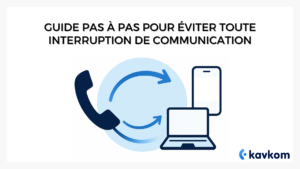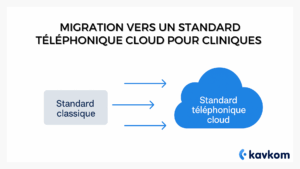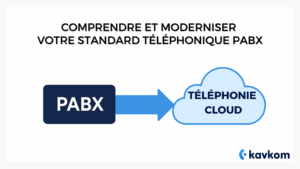Is your current telephone system too costly and preventing you from being flexible? Are you looking to modernize your telephony system without investing in obsolete equipment, while guaranteeing call quality and continuing to monitor communications?
Are you looking for a solution to replace your current phone system with high-performance VoIP cloud telephony? In this article, you’ll find a precise definition, a step-by-step guide to migrating without hardware, and directly applicable advice.
Points to remember :
- VoIP cloud telephony replaces heavy hardware with a 100% online solution. It operates via the Internet, without a physical server, and enables calls to be made from a browser, softphone or cell phone.
- The benefits are clear: reduced costs (no more hardware maintenance), total flexibility (telecommuting, multisite), seamless CRM integration and real-time supervision via dashboards and KPIs.
- Migration to VoIP cloud is a 5-step process: needs analysis, choice of a suitable provider (like Kavkom), technical configuration, team training, then supervision and optimization.
- Kavkom facilitates this transition with a hardware-free solution, rapid installation, native integration with leading CRMs (Salesforce, HubSpot, Zoho…) and French-speaking human support.
Defining VoIP cloud telephony: concepts and differences
Before talking about solutions and suppliers, it’s important to understand what VoIP cloud telephony really is. It’s a fairly technical term that can be frightening when you’re not familiar with it, but in reality, it describes a simple, modern way of operating business telephony.
What is VoIP?
VoIP stands for Voice over Internet Protocol. Simply put, it’s a technology that enables telephone calls to be made via the Internet, rather than over traditional telephone lines. It works by using software or IP telephones that convert voice into digital data.
What about cloud telephony?
Cloud telephony is a telephony system hosted in the cloud, i.e. on remote servers accessible via the Internet. Unlike old-fashioned switchboards (PBXs installed on site), everything is managed online, with no hardware infrastructure to maintain locally.
What difference does it make in the workplace?
- No need for expensive equipment
- Calls manageable from anywhere
- Can be integrated with business tools (CRM, helpdesk, etc.)
- Real-time call supervision
In concrete terms: VoIP cloud telephony is business telephony that’s modernized, flexible, economical and connected.
The benefits of VoIP cloud telephony for your call center
VoIP cloud telephony isn’t just a technical alternative: it’s a real optimization lever for call centers. It transforms the way teams manage calls, collaborate and monitor performance, while reducing costs and hardware constraints.
Cost reduction
Cloud telephony requires no physical switchboards, fixed lines or technical intervention. The cloud reduces installation, maintenance and upgrade costs.
According to findstack.fr, 82% of companies that have migrated to the cloud report savings.
Flexibility and mobility
Agents can manage their calls from a computer, tablet or cell phone, whether in the office or at home. Hours are more flexible, and access much less restricted.
Scalability
Add or remove users in just a few clicks. There’s no need to order equipment or go back to a technician each time a new user is recruited or upgraded. Everything is managed 100% online.
Seamless integration with your tools
The best VoIP cloud solutions integrate natively with your CRM, ticketing tools or business software. This enables automatic feedback of customer records, better tracking of interactions and greater productivity.
For example, Kavkom’ s cloud telephony solution lets you manage calls, recordings and real-time supervision directly from the cloud, without any hardware. It’s quick to install, and offers CRM integration, perfectly suited to the needs of a modern call center.
To sum up: VoIP cloud telephony simplifies organization, improves team responsiveness, and enables better performance management, while reducing costs. So why not start now?
How do you choose between VoIP telephony and traditional solutions?
When it comes to modernizing a call center or sales team, the choice of telephone system is an important one. Should you keep a traditional system (such as an on-site PBX) or migrate to a VoIP cloud solution? Here’s a comparison to help you decide.
Traditional telephony (on-premise PBX)
For traditional telephony, here are the main things you need to know to make the right choice:
- Costly installation: cabling, servers, workstations… all require heavy hardware investment.
- Complex maintenance: any malfunction involves physical intervention, with associated delays and costs.
- Lack of flexibility: adding a line, modifying a routing or equipping a teleworker requires considerable technical resources.
- Limited scalability: the system often needs to be oversized to anticipate growth… or replaced if it becomes obsolete.
- Less resilient: in the event of a local failure (power cut, internal network problem), the entire infrastructure is at a standstill.
VoIP cloud telephony
VoIP cloud telephony is much simpler:
- No on-site hardware: everything is done over the Internet, using software or softphones.
- Quick commissioning: installation in just a few hours, without a technician.
- Remote management: calls, queues, users… everything can be configured via a web interface.
- Highly resilient: in the event of a local failure, calls are automatically redirected.
- Cloud solutions are less sensitive to downtime, as they are not dependent on on-site hardware.
For call and sales centers
VoIP cloud is particularly well suited to mobile, multi-site or telecommuting teams. It lets youadjust staffing levels in real time, monitor calls and connect telephony to CRM to automate customer follow-up.
In short: more flexible, more economical, easier to upgrade, the cloud is the logical choice for today’s businesses, especially those that work remotely.
Step-by-step guide to migrating to a hardware-free VoIP cloud solution
Switching from a traditional telephone system to a VoIP cloud solution is not something you can improvise. To make the transition smooth, efficient and well accepted by your teams, you need to follow a well-defined method. Here’s a 5-step guide to a successful transformation.
1. Assess your needs
Before choosing a tool, it is important to understand your current uses and objectives:
- How many lines do you use?
- Are your teams on-site, telecommuting or distributed?
- Do you need call recording?
- Should your calls go into a CRM?
- Do you have seasonal traffic peaks?
The aim: to draw up a simple map of your current operations, so you can choose a solution that best suits your reality and expectations.
2. Choose the right supplier
Not all tools are created equal. The right supplier should offer :
- A hardware-free cloud solution, accessible from a browser or application
- Quick installation, no technical intervention required
- Native CRM integration
- Responsive, human support in French
- Flexible, no-obligation pricing
That’s exactly what Kavkom offers. The solution lets you deploy your cloud telephony in just a few hours, without any infrastructure. Support is available from configuration to ramp-up. All with no hidden costs or commitments. Their strength: seamless integration with CRMs such as HubSpot, Salesforce or Zoho, and real-time supervision designed for managers.
3. Set up CRM configuration and integration
Once the tool has been chosen, it is necessary to :
- Create user accounts
- Set up call groups, schedules and queues
- Activate important functions: recording, playback, redirection
- Link telephony software to your CRM (click-to-call, customer records, integrated call logs)
Example: with Kavkom, parameterization can be finalized very quickly, thanks to the software’s ease of use, and the support you can request.
4. Training and deployment for your teams
Even an intuitive tool requires a minimum of support. Get ready:
- A short training session (30-45 min)
- A user guide (shortcuts, best practices)
- An internal point of contact for initial questions
Tip: include a short “check-in” with the team 3 days after start-up to ensure that everything is running smoothly.
5. Monitoring, supervision and optimization
Once the system is in place :
- Analyze your indicators: waiting time, pick-up rate, call duration
- Listen to the recordings to coach your teams
- Adjust schedules or call distribution according to activity peaks
- Easily add agents without installation
With a tool like Kavkom, you can access this data in real time. The platform lets you monitor your performance day by day, effortlessly.
Integration and real-time supervision: guaranteeing call quality
High-performance cloud telephony isn’t just about making calls. What really makes the difference is your ability to monitor what’s happening in real time: audio quality, queue saturation, team efficiency… Everything must be able to be analyzed on the fly.
Supervision tools
Modern VoIP solutions like Kavkom integrate a call wall and live dashboards that display :
- Number of calls in progress or on hold
- Status of each agent (available, on call, absent)
- Performance by team or agent
These tools enable you to react immediately to peaks in activity or drops in quality.
KPIs to monitor closely
- Average response time
- Pick-up rate
- Call transfer rate
- Average call duration
- Maximum waiting time
- Number of missed calls
By analyzing this data on a daily basis, you can detect friction, adjust your resources and improve the customer experience.
A direct lever for productivity
According to a study by psico-smart.com, companies that integrate real-time analysis into their processes see a 20-30% increase in productivity.
FAQ – Frequently asked questions
What’s the difference between a VoIP line and a VoIP server?
A VoIP line is a virtual telephone number used to make and receive calls via the Internet, from a softphone, browser or IP phone.
A VoIP server is the system that manages these calls: it orchestrates connections, transfers, queues and recordings.
What are the disadvantages of VoIP?
VoIP depends on a stable Internet connection. If the network is unstable, audio quality may deteriorate. It also requires sufficient bandwidth to avoid interruptions. Finally, some advanced functions may require a bit of initial configuration, which is why it’s a good idea to choose a service provider like Kavkom, who can help with installation and provide ongoing human support.
What is a Cloud PBX and what is it for?
A cloud PBX (Private Branch Exchange) is a telephone switchboard hosted in the cloud. It manages internal and external calls, call forwarding, voicemail messages, waiting groups… but without a physical server on your premises. It offers all the advantages of a traditional PBX, with greater flexibility, lower costs and remote administration.
Conclusion
VoIP cloud telephony is the obvious choice for companies looking to modernize their communications. More flexible, more economical and easier to manage, it offers advanced functionalities that significantly improve responsiveness, supervision and customer relations – essential levers for call centers and sales teams.
Tools like Kavkom make the transition simple: no hardware, rapid installation, native integration with CRMs and human support every step of the way. Real-time supervision, logging and performance indicators keep you in control, while facilitating the work of your teams.
In short: by opting for a VoIP cloud solution, you gain flexibility, reduce costs, and lay the foundations for modern, scalable, efficiency-focused telephony.





